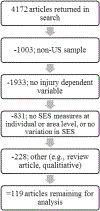A systematic review of socioeconomic status measurement in 13 years of U.S. injury research
- PMID: 29636170
- PMCID: PMC10372816
- DOI: 10.1016/j.jsr.2017.12.017
A systematic review of socioeconomic status measurement in 13 years of U.S. injury research
Abstract
Objective: The purpose of this review was to assess the impact of socioeconomic status (SES) on injury and to evaluate how U.S. injury researchers have measured SES over the past 13years in observational research studies.
Design & methods: This systematic review included 119 US injury studies indexed in PubMed between January 1, 2002 and August 31, 2015 that used one or more individual and/or area-level measures of SES as independent variables. Study findings were compared to the results of a previous review published in 2002.
Results: Findings indicate SES remains an important predictor of injury. SES was inversely related to injury in 78 (66%) of the studies; inverse relationships were more consistently found in studies of fatal injury (77.4%) than in studies of non-fatal injury (58%). Approximately two-thirds of the studies (n=73, 61%) measured SES along a gradient and 59% used more than one measure of SES (n=70). Studies that used a gradient measure of SES and/or more than one measure of SES identified significant relationships more often. These findings were essentially equivalent to those of a similar 2002 review (Cubbin & Smith, 2002).
Conclusions: There remains a need to improve measurement of SES in injury research. Public health training programs should include best practices for measurement of SES, which include: measuring SES along a gradient, selecting SES indicators based on the injury mechanism, using the smallest geographic region possible for area-level measures, using multiple indicators when possible, and using both individual and area-level measures as both contribute independently to injury risk. Area-level indicators of SES are not accurate estimates of individual-level SES.
Practical applications: Injury researchers should measure SES along a gradient and incorporate individual and area-level SES measures that are appropriate to the injury outcome under study.
Keywords: Injury; Injury research methodology; Measurement; Measurement of socioeconomic status; Methodology; Socioeconomic Status; Systematic Review.
Copyright © 2017 National Safety Council and Elsevier Ltd. All rights reserved.
Similar articles
-
Folic acid supplementation and malaria susceptibility and severity among people taking antifolate antimalarial drugs in endemic areas.Cochrane Database Syst Rev. 2022 Feb 1;2(2022):CD014217. doi: 10.1002/14651858.CD014217. Cochrane Database Syst Rev. 2022. PMID: 36321557 Free PMC article.
-
The effect of socio-economic status on non-fatal outcome after injury: A systematic review.Injury. 2017 Mar;48(3):578-590. doi: 10.1016/j.injury.2017.01.013. Epub 2017 Jan 5. Injury. 2017. PMID: 28077211 Review.
-
Socioeconomic status and non-fatal injuries among Canadian adolescents: variations across SES and injury measures.BMC Public Health. 2005 Dec 12;5:132. doi: 10.1186/1471-2458-5-132. BMC Public Health. 2005. PMID: 16343342 Free PMC article.
-
Multilevel analysis of associations between socioeconomic status and injury among Canadian adolescents.J Epidemiol Community Health. 2005 Dec;59(12):1072-7. doi: 10.1136/jech.2005.036723. J Epidemiol Community Health. 2005. PMID: 16286497 Free PMC article.
-
Socioeconomic inequalities in injury: critical issues in design and analysis.Annu Rev Public Health. 2002;23:349-75. doi: 10.1146/annurev.publhealth.23.100901.140548. Epub 2001 Oct 25. Annu Rev Public Health. 2002. PMID: 11910067 Review.
Cited by
-
Understanding pathways to social inequalities in childhood unintentional injuries: findings from the UK millennium cohort study.BMC Pediatr. 2019 May 15;19(1):150. doi: 10.1186/s12887-019-1514-7. BMC Pediatr. 2019. PMID: 31088415 Free PMC article.
-
Material deprivation and rates of all-terrain vehicle- and snowmobile-related injuries in Ontario from 2003 to 2018: a population-based study.Can J Public Health. 2021 Apr;112(2):304-312. doi: 10.17269/s41997-020-00416-0. Epub 2020 Oct 14. Can J Public Health. 2021. PMID: 33052587 Free PMC article.
-
Evaluation of a mobile safety center's impact on pediatric home safety knowledge and device use.Inj Epidemiol. 2020 Jun 12;7(Suppl 1):27. doi: 10.1186/s40621-020-00254-1. Inj Epidemiol. 2020. PMID: 32532361 Free PMC article.
-
The Socioeconomic Characteristics of Childhood Injuries in Regional Victoria, Australia: What the Missing Data Tells Us.Int J Environ Res Public Health. 2021 Jun 30;18(13):7005. doi: 10.3390/ijerph18137005. Int J Environ Res Public Health. 2021. PMID: 34209051 Free PMC article.
-
[Homicides in young people and social inequalities in Mexico, 2017Homicídios em jovens e desigualdades sociais no México, 2017].Rev Panam Salud Publica. 2019 Dec 6;43:e94. doi: 10.26633/RPSP.2019.94. eCollection 2019. Rev Panam Salud Publica. 2019. PMID: 31889953 Free PMC article. Spanish.
References
-
- Adler, Boyce, Chesney, Cohen, Folkman, Kahn, & Syme (1994). Socioeconomic status and health: The challenge of the gradient. American Psychologist, 49(1), 15. - PubMed
-
- Allareddy, Itty, Maiorini, Lee, Rampa, Allareddy, & Nalliah (2014). Emergency department visits with facial fractures among children and adolescents: An analysis of profile and predictors of causes of injuries. Journal of Oral and Maxillofacial Surgery, 72(9), 1756–1765. - PubMed
-
- Anderson, Pomerantz, & Gittelman (2014). Intentional injuries in young Ohio children: Is there urban/rural variation? Journal of Trauma and Acute Care Surgery, 77(3), S36–S40. - PubMed
-
- Bilston, Finch, Hatfield, & Brown (2008). Age-specific parental knowledge of restraint transitions influences appropriateness of child occupant restraint use. Injury Prevention, 14(3), 159–163. - PubMed
Publication types
MeSH terms
Grants and funding
LinkOut - more resources
Full Text Sources
Other Literature Sources
Medical
Miscellaneous


